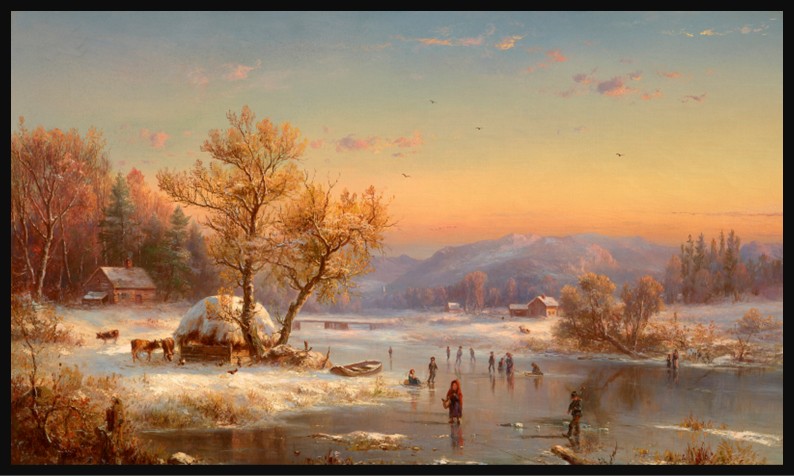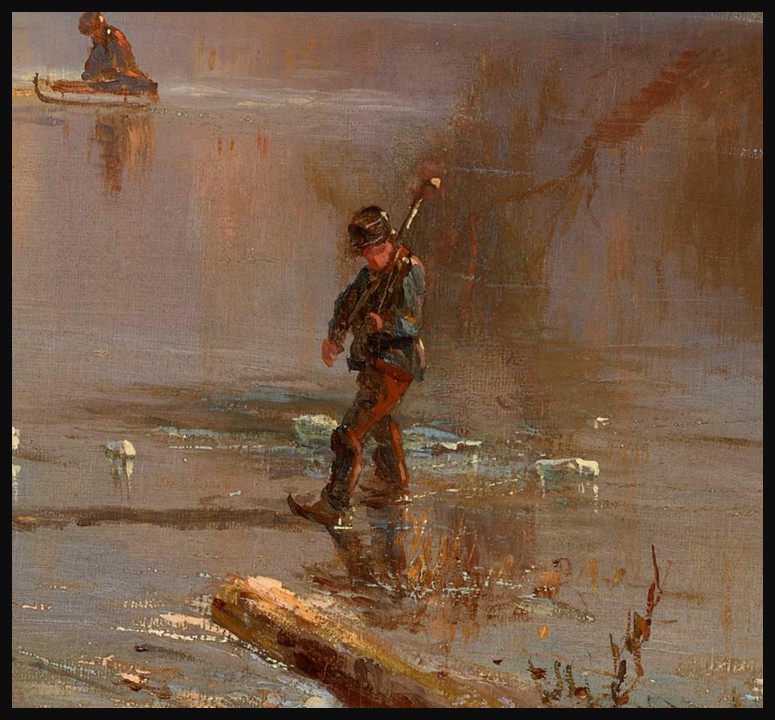
Winter Evening in the Country, 1865, Oil on Canvas, 61 x 102.2 cm, Private Collection https://www.christies.com/en/lot/lot-6519595?ldp_breadcrumb=back#lot-essay
Jasper Francis Cropsey’s Winter Evening in the Country captures the serene stillness and frosty charm of a rural landscape wrapped in winter’s embrace, evoking the timeless imagery of Christina Rossetti’s poignant verse… In the bleak midwinter, frosty wind made moan, / Earth stood hard as iron, water like a stone; / Snow had fallen, snow on snow, snow on snow, / In the bleak midwinter, long ago… Cropsey, a master of the Hudson River School, imbues the scene with a poetic tranquility that mirrors Rossetti’s reflection on the stark beauty and quiet solemnity of winter. The painting’s soft, fading light against the glistening snow and frozen streams resonates with the deep reverence for nature and its cyclical rhythms, so beloved by 19th-century American Romanticism. Viewed through this lens, Winter Evening in the Country becomes not just a landscape, but a visual hymn to the season’s austere grace, much like Rossetti’s enduring words. https://www.poetryfoundation.org/poems/53216/in-the-bleak-midwinter
Jasper Francis Cropsey (1823–1900) was a celebrated American painter and architect, best known for his vivid and romantic depictions of the American landscape, particularly during autumn. Born in Staten Island, New York, Cropsey initially trained as an architect but soon turned to painting, inspired by the natural beauty of his surroundings. He became associated with the Hudson River School, a group of artists who celebrated the grandeur of America’s untamed wilderness. Cropsey’s artistic career flourished in both the United States and Europe, with his work frequently exhibited at prestigious institutions like the Royal Academy in London. Deeply rooted in a transcendental appreciation of nature, his art also carried patriotic undertones, reflecting an idealized vision of America’s expanding frontier during the 19th century.
The aesthetics of Cropsey’s oeuvre are characterized by a meticulous attention to detail, luminous colour palettes, and a romantic interplay of light and atmosphere. He had a particular affinity for autumnal landscapes, often portraying scenes with radiant foliage, expansive skies, and tranquil waterways, which became hallmarks of his style. Cropsey’s ability to balance naturalistic detail with an almost spiritual grandeur imbued his works with a sense of awe and serenity. His paintings often celebrate not only the beauty of nature but also its capacity to evoke contemplation and reverence. By blending realism with idealism, Cropsey’s art encapsulates the optimism and nationalism of the Hudson River School while inviting viewers into a profound communion with the natural world.
Jasper Francis Cropsey’s Winter Evening in the Country is a serene and evocative portrayal of a rural landscape enveloped in the stillness of winter. The painting captures a quiet countryside blanketed in snow, illuminated by the soft, fading light of dusk. Cropsey’s meticulous attention to detail is evident in the delicate rendering of the leafless trees, the snow-laden rooftops, and the icy stream that meanders through the composition. The warm glow emanating from the windows of the farmhouse contrasts gently with the cool blues and grays of the surrounding snow, creating a harmonious balance between warmth and chill. This idyllic scene reflects Cropsey’s mastery of light and atmosphere, drawing the viewer into a tranquil moment of reflection on the beauty of nature.

Winter Evening in the Country (detail), 1865, Oil on Canvas, 61 x 102.2 cm, Private Collection https://www.christies.com/en/lot/lot-6519595?ldp_breadcrumb=back#lot-essay
Created during the aftermath of the American Civil War, Winter Evening in the Country subtly reflects the cultural and emotional climate of the time. The painting’s peaceful rural setting can be seen as a nostalgic yearning for unity and stability in the face of the nation’s recent turmoil. Amid the tranquil scene, a boy dressed as a Union soldier and carrying a rifle, is a poignant reminder of the war’s enduring presence in the collective memory of Americans. His inclusion in the idyllic landscape juxtaposes the serenity of the countryside with the lingering echoes of conflict. The untouched snow and the quiet countryside symbolize renewal and healing, suggesting a return to simplicity and the enduring strength of the American spirit. Cropsey’s choice to focus on the enduring beauty of the land, while subtly acknowledging the sacrifices of those who fought, underscores the Hudson River School’s broader mission to celebrate the natural world as a source of solace and hope. In this way, the painting becomes more than a pastoral winter scene; it is a quiet testament to resilience and optimism in the wake of national strife.
For a PowerPoint Presentation on Jasper Francis Cropsey’s Oeuvre, please… Check HERE!
Bibliography:https://www.nga.gov/collection/artist-info.1191.html